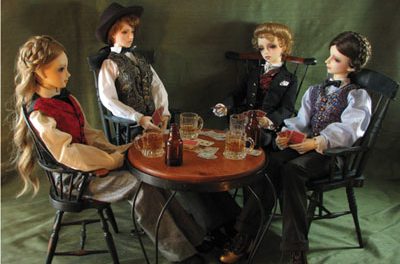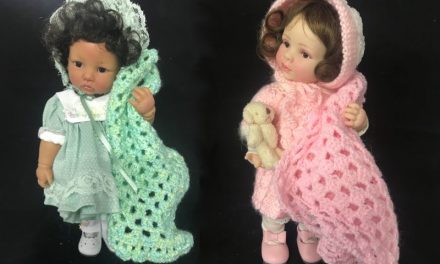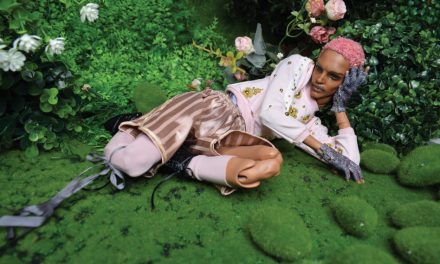From the very first doll they created in 1976 in a small corner of their modest apartment to the modern masterpieces in felt they produce today in a multi-building production facility, the distinctive works of John and Susan Wright have earned this talented couple a prominent place in the pantheon of doll artists. Their range of work—dolls, bears and animals— make R. John Wright Dolls one of the few companies to effectively bridge the gap between these various fields. And they do it with distinctive style and that hallmark “R. John Wright” look, which discriminating collectors have come to cherish and covet over the years.
In recognition of his outstanding achievements and significant contributions to doll art, Jones Publishing is awarding R. John Wright with its Lifetime Achievement Award, which at press time, was scheduled to be presented at the Doll & Teddy Bear Expo in Washington, DC, on August 20.
DOLLS editor Nayda Rondon managed to pry them away from their workbenches long enough to reflect on their careers and each other. Enjoy their comments below.
DOLLS: In a career full of highs and achievements, what are some experiences that stand out for you as especially meaningful?
RJW: The early realization that we could actually earn our living by making dolls was very significant to us. It never ceases to amaze. We still stop and look around and say “all this was made possible by dolls.” Then, once we got going, the high points kept coming—our first children dolls, election to NIADA, our first Disney contract, the Beatrix Potter contract, Raggedy Ann, etc. Most recently, the dream of having our business near our home in Vermont has come true.
DOLLS: What was your reaction upon learning that you would be receiving Jones Publishing’s Lifetime Achievement Award?
RJW: Dread! Horror! I realized that this is an honor, but the term “Lifetime Achievement” seemed to imply conclusion—and we are far from done. In fact, I tried to get Joe [Jones, publisher of Jones Publishing] to change the title of the award to something a little less ominous sounding. But in the end we decided that the gracious thing to do was just to accept it!
DOLLS: What was the lowest point in your career, and how did you overcome it?
RJW: There have never been artistic low points, or times when the work ceased to compel us. But there certainly have been a few times when we reached financial low points. Before we began making dolls, Susan and I were actually homeless and slept outside at night. We have been rock bottom together, and having experienced that and survived, we are ever confident that the pendulum will always eventually swing the other way.
Once when we had exactly $20 to our name, we visited the Metropolitan Museum in New York (admission free). Mid-day found us in a line at the cafeteria, although we couldn’t justify being there! We were asked “fish or beef.” Our reply: “I’ll take the fish” has become an inside joke between us of our cockeyed optimism. Susan gasped when I selected a carafe of wine to accompany our meal. We ate in style, secure in the knowledge that somehow, some way, we would survive.
DOLLS: Was there ever a time when you thought of quitting?
RJW: If we were to quit, we would need to replace it with something else. What else could we do?! I have done a lot of other things before dollmaking—as has Susan—but nothing compares to this. Even early retirement would leave a big hole for us since the work we do sustains us emotionally.
DOLLS: What gave you the courage to take that leap of faith that compelled you to create your very first doll in 1976?
RJW: I am grateful that somehow I was given the strength—and the unfounded optimism—to begin making dolls. I don’t know where that came from, but it was like being on the edge of a cliff with no other alternative but to jump. I’m glad I did. But even if I had failed, it would be preferable to never knowing.
DOLLS: What were you two thinking (and thank goodness you did) when you made the joint decision to give up Susan’s secure salary and go for your dream of dollmaking?
RJW: Actually, that was a fairly easy decision at the time. We were amazed at how quickly we became self-sufficient. My experience of being laid off from my job made me determined to never be in that position again. If you are self-employed, you can’t lose your job.
DOLLS: Even at this point in your careers, many people still have the perception that you are the sole creative force behind RJW. What is Susan’s role and that of other individuals on your creative team?
RJW: Susan likes to point out that what we do is 10 percent inspiration and 90 percent perspiration. I provide much of the inspiration, but it would never become a reality without everything else. I generally bring the ideas to the table, but Susan joins me in the creative decisions involved in making the prototype. We work together but I am generally more cerebral while she is more “hands on.” Still, it’s difficult to pinpoint our roles because they shift and cross over during development.
 I like to say that we take turns giving up! We work with our model maker for development of the sculptures and with our mold maker for the metal molds required. Once the prototype is completed, the really difficult work of putting the item into production begins. Susan is the critical bridge between prototype and production. Our trained team of artisans (approximately 40 people) actually produces the dolls. By then, of course, I am off on to the next “idea,” which sometimes involves licensing negotiations and other non-artistic pursuits.
I like to say that we take turns giving up! We work with our model maker for development of the sculptures and with our mold maker for the metal molds required. Once the prototype is completed, the really difficult work of putting the item into production begins. Susan is the critical bridge between prototype and production. Our trained team of artisans (approximately 40 people) actually produces the dolls. By then, of course, I am off on to the next “idea,” which sometimes involves licensing negotiations and other non-artistic pursuits.
DOLLS: Looking ahead to the next decades of creation, what do you hope to accomplish?
RJW: We absolutely love our new location here in Bennington because it presents an array of wonderful new possibilities. We hope to establish our museum here as well as a retail “company” store. We’d like to offer factory tours and possibly special events. It is our hope that the setting and the facility will become a great destination for collectors.
DOLLS: You have fans not only among collectors but among other doll artists as well. Who among the current landscape of doll talents do you look to with admiration?
RJW: We admire many of the small dollmakers who do excellent, artistic work. Among them: Brigitte Deval, Sissel Skille, Beatrice Perini, Ella Hass and Bets van Boxel. Among the doll manufacturers, Robert Tonner, Helen Kish and Annette Himstedt continually do work that collectors love while maintaining their individual artistic vision and integrity. This short list attests to how difficult this is to achieve.
DOLLS: Throughout your lives and careers who have been some of your mentors or sources of inspiration?
RJW: Although we admire the work of contemporary doll artists and companies, much of what they do does not apply to our work. Most doll artists work alone or design for other companies. Very few have decided to form their own workshops to produce their designs themselves. Others design dolls but their dolls are produced overseas, generally in Asia. Instead of these two options, our inspiration has always been the old companies from the Golden Age of dolls and toys: Steiff, Käthe Kruse, Madame Alexander, Lenci, Bru, K*R, Shoenhut and Marklin. These companies produced work which we avidly collect and identify with, and we like to think of ourselves as extensions of that type of “artistic manufacturing,” which is increasingly rare.
DOLLS: Any “words of wisdom” for fledgling doll artists?
RJW: If you love what you do, it ceases to be a “job.” This is the message we impart to our own children as they seek their careers and life’s calling. If someone is drawn to dolls and toys, and feels he or she has a talent to design them, I would encourage the person to “take the leap.” Find an area of doll making that you can excel in. Devote yourself completely to being the best you can possibly be in that area. This will require you to be your own worst critic, but the rewards are endless.
DOLLS: Your pieces speak to the magic of childhood and of the great love, almost reverent respect for toys and their power. How have you managed to hold on to this feeling of child-like fascination instead of outgrowing it as so many adults do?
RJW: In The Art of Toys by Krystyna Poray Goddu I recount a moment that stands out from my childhood when I willed myself to not lose the feeling and love I had for toys. I could see that most adults no longer had that emotion and I desperately wanted to retain it. Fortunately, I found a career and a creative partner in Susan that have enabled me to do so.







